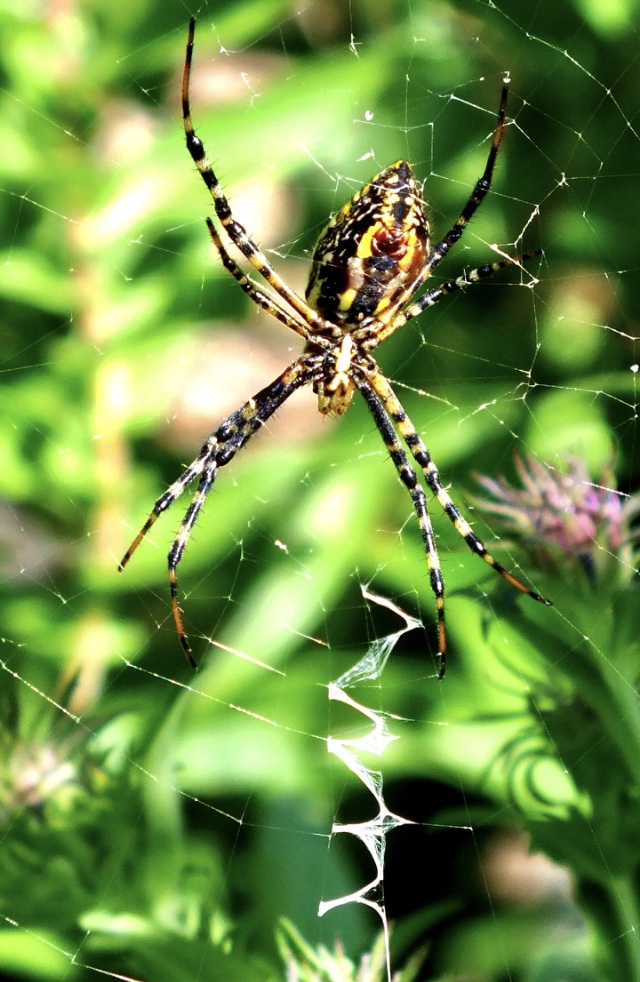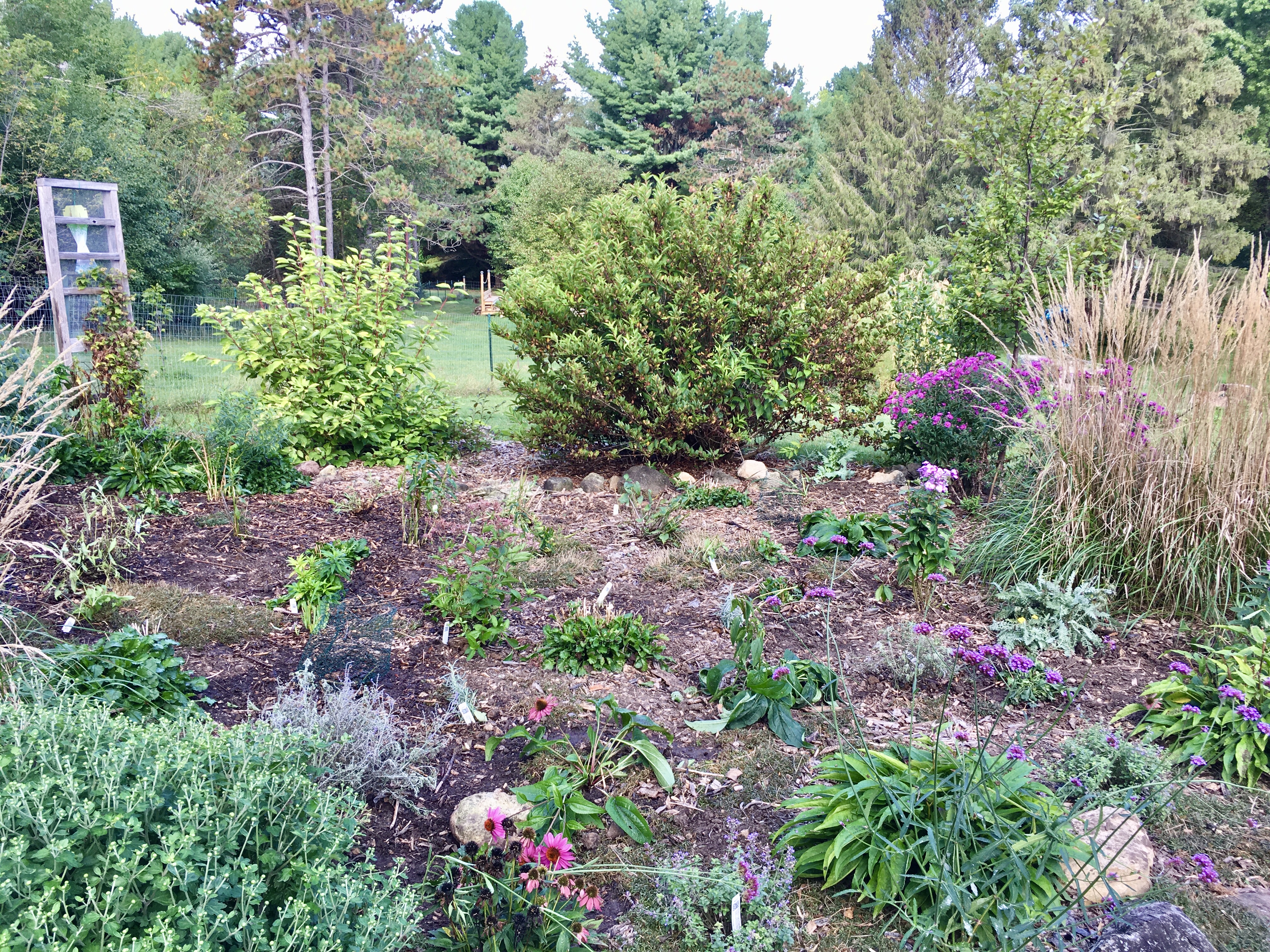I’m sidelined this weekend by an iced knee and bit of pain, so I’m sharing one of my favorite old posts, from October 2011, with a brief update. Gentle Peace to all. xoxoxo Kitty

It is a truth universally acknowledged that a single spider in possession of a good web must be in want of prey. But in the garden this season, I learned again that there are many ways we nourish and are nourished.
I first met Jane in early August, when I was weeding the large garden near the river. She had woven her distinct web across one of the sage plants, and its intricate stabilimenta zig-zagged, zipper-like, across the orb-web’s center. She was the largest and most brilliantly-colored garden spider I’d ever seen, so I fetched the camera and took several pictures from a respectful distance, and later researched her species and background. Her scientific classification was logical: Kingdom: Animalia; Phylum: Anthropoda; Class: Arachnida; Order: Araneae; Family: Araneidae; Genus: Argiope; and Species: Argiope Aurantia (like an orange, though she was colored in brilliant yellow and black).
When I learned that one of her nicknames is “the writing spider,” she of course became further classified as a kindred spirit, and I christened her “Jane” after Jane Austen, a name to which she did not evidence rejection. For more than a month, we met several times a week, and she hospitably endured my observations.
Understand, Gentle Reader, that were Jane to visit my home’s interior, the sound of my arachnophobic screams would make international (and possibly intergalactic) news, but spiders do not bother me when they are outside, weaving their webs and living their lives within the larger web of nature, the home we all share.
Miss Jane, I learned, liked to remain in one place for most of her life, a homebody like myself. The creation of her web took hours and its complexity was miraculous: its architecture could be up to two feet across and up to eight feet off the ground. She usually remained at the web’s midpoint, head down (as I always found her), awaiting innocent prey’s entanglement. When I met her, the remaining wing of a swallowtail butterfly decorated her web, as did bits and pieces of insects.
Jane consumed the center of her web each night, possibly for nourishment or to recycle chemicals used in the web’s construction, and re-wove it daily, including the delightful “written” zipper (“stabilimenta”) across the middle. I could not discover a definitive explanation for this part of her web, except that some scientists have suggested it may serve as camouflage or in some way attract prey. I also learned that among orb-weavers, the Aurantia is known for her unusually tidy and clean web. Other orb-weavers are content with disorder, clutter, and mess. Jane rose yet again in my regard and respect. I never met Jane’s mate. He would have woven a “lesser” web nearby, including an escape line in case she attacked him; at any rate, he died after their love was consummated and she likely ate him. (Understandably, my husband Phillip does not like this part of Jane’s story.) But Jane’s partner did exist, for one day I discovered the egg sac, a delicate brown silken ball almost an inch in diameter, fixed near the web’s enter, and Jane hanging nearby, guarding it as vigilantly as any artist watches over her creation. I read that within this tiny ball, up to 1,400 eggs were settled and would be harbored till spring, were they not harmed by birds, the elements, or other likely hazards.
We had a gentle frost one night several weeks after Jane and I became garden companions, and Jane was nowhere to be found; it is the common way for females of her species to die. I mourned her loss; we had an elegant, mutually intriguing (or so it seemed to me) relationship.
When I cut back the plants this weekend and neared the sage that was Jane’s home, I gently severed the branch holding her egg sac, and placed it under an evergreen shrub, settled within a bed of sedum and violets.
If the egg sac survives through winter, one day next spring, I could see what seems to be pollen or dust collecting within the silken sac…the tiny bodies of Jane’s progeny responding to Love’s call to write their own life stories. I hope some will decide to stay and grace our gardens with the elegance and artistry—and kinship—I shared with their mother.
We’re all here such a precious little while, invited to write the words, dance the dance, and create the art seeded within our spirits at its inception; the whole of life depends upon both our singular contributions and our abilities to form connections that welcome, encourage, and sustain the unique contributions of others.
It may be in the nature of the Kingdom Animalia to capture and devour prey; however, the instinct to forge connection and co-exist with deep humility, hospitality, and respect is also a lovely part of our mysterious story. In relationship, we nourish and are nourished.
Thank you, Jane.
Update: Every year since I published this, I’ve searched for members of Jane’s successive generations, and there have been many. This year I found several, and was happy to welcome them and share stories. This one looks so much thinner than Jane; I wonder how our months-long drought and diminished insect population have affected her. I’m checking often, as able, for her egg sac and hope we’ll see her daughters next year. Our families have formed a connection, you see, and that is rare and precious.

And this beautiful orb weaver spun her amazing web on the exterior (thank heaven) of a deck door. She’s not as large as this photo makes her appear, but she is quite an attractive specimen. Were she inside my home, as I mentioned 10 years ago, my head would no longer be attached, having exploded with fright, but outside where I can safely admire her, I must admit she’s gorgeous, and we have had so few guests for so long, that it feels good to practice hospitality again, to form a tentative relationship and be grateful for her presence and gifts.

© Copyright of all visual and written materials on The Daily Round belongs solely to Catherine M. O’Meara, 2011-Present. Unauthorized use is strictly prohibited, without the author’s written approval. No one is authorized to use Catherine O’Meara’s copyrighted material for material gain without the author’s engagement and written permission. All other visual, written, and linked materials are credited to their authors. Thank you, and gentle peace.


















You must be logged in to post a comment.